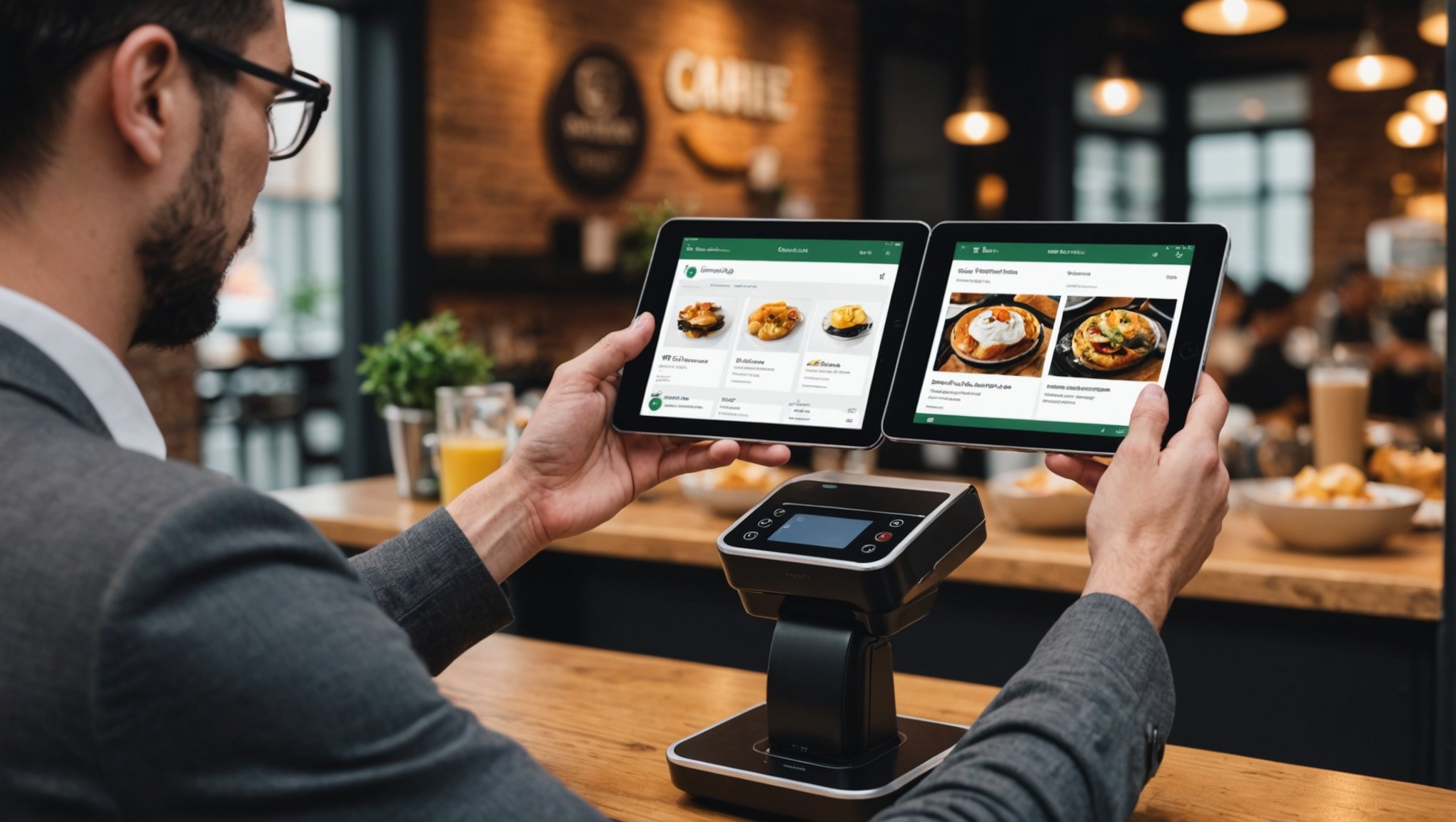Transforming Café Orders: Cutting-Edge Tech Innovations for an Effortless Experience
In the fast-paced world of the restaurant industry, staying ahead of the curve is crucial for survival and success. One of the key areas where technology is making a significant impact is in the ordering process. From contactless payments to AI-driven kitchen operations, the latest innovations are revolutionizing how cafes and restaurants manage orders, enhancing both the customer and the business experience.
The Rise of Contactless Payments and QR Codes
One of the most notable trends in restaurant technology is the adoption of contactless payment methods, particularly QR codes. This shift is driven by consumer demand for convenience, hygiene, and speed.
Also read : Top Flooring Solutions to Reduce Noise in Open Kitchen Restaurants: A Comprehensive Guide
How QR Codes Are Changing the Game
QR codes have become a staple in many restaurants, allowing customers to order and pay seamlessly using their mobile devices. For instance, the PAR POS Fall Release includes a feature called PAR Pay, which enables guests to settle checks instantly via QR codes. This solution not only speeds up table turnover but also boosts average tips by 16% and allows staff to focus more on delivering exceptional service.
Key Benefits of QR Code Payments:
- Speed up table turnover
- Increase average tips
- Reduce wait times
- Enhance customer convenience
- Improve staff efficiency
Real-World Implementation
Restaurants like those using the PAR POS system are seeing significant improvements. “With this release, we’re pushing the boundaries of what restaurant technology can achieve,” said Savneet Singh, CEO of PAR Technology. “The PAR POS Fall Release brings forth impactful solutions, like QR code payments, native digital wallets, and new order modes, transforming how restaurants engage with their customers”.
In the same genre : Elevate Your Menu: Creative Ways to Incorporate Tea Pairings in a Classic British Restaurant
Ordering 2.0: A New Paradigm in Digital Engagement
The traditional online ordering system, often referred to as Ordering 1.0, is no longer sufficient in today’s digital-first world. Ordering 2.0 represents a paradigm shift, focusing on creating memorable experiences rather than just facilitating transactions.
Customized Brand Experiences
Ordering 2.0 is about more than just ordering food; it’s about crafting unique, unforgettable experiences. Restaurants can design adaptable platforms that resonate with customers, offering personalized interactions that build brand loyalty. For example, Crumbl Cookies’ app allows customers to track rewards, personalize orders, and build stronger brand bonds, moving beyond the transactional nature of older systems.
Features of Ordering 2.0:
- Customized Brand Experiences
- Simplified User Experience
- Centralized Management
- Adaptable Drivers of Growth
- Holistic Data Ownership
- Personalized Support
- Innovative Technology
Overcoming Implementation Challenges
To fully leverage Ordering 2.0, restaurants must address several challenges. This includes ensuring strong security measures to protect customer data, providing comprehensive training for staff to ease the transition, and partnering with experienced technology providers to handle integration complexity. By taking these steps, restaurants can create digital experiences that attract repeat business and drive sustained growth.
Enhancing Operational Efficiency with Advanced POS Systems
Point-of-sale (POS) systems are the backbone of any restaurant’s operations. The latest advancements in POS technology are designed to enhance operational efficiency, boost customer satisfaction, and future-proof restaurants.
Platform Extensibility and Data Management
The PAR POS Fall Release, for instance, offers significant enhancements in platform extensibility and data management. Restaurants can now integrate kiosks, menu boards, and other external systems directly within the restaurant via local RESTful API endpoints. This in-store integration strengthens in-store reliability, even during internet outages, and allows for faster, more responsive ordering experiences since the data is processed locally.
Streamlined Order Processing
Features like Rapid Promo Entry and On the Fly, One Behind Ordering are designed to streamline transactions and reduce errors. Rapid Promo Entry allows restaurants to automatically apply promotion items to orders with a simple promo code, while On the Fly, One Behind Ordering holds items back from the kitchen display until the next item is finalized, preventing early preparation and reducing food waste.
Multi-Lane Drive-Thru Innovations
For restaurants with drive-thru services, the latest technology is transforming the experience, making it more efficient and accurate.
Multi-Lane Drive-Thru Enhancements
The PAR POS Fall Release includes Multi-Lane Drive-Thru Enhancements, which assign a default register to an Order Confirmation Board (OCB), persisting day-to-day to eliminate the need for repeated setup. An indicator on the register shows the assigned OCB, improving visibility and order accuracy while reducing labor effort and staff frustration.
The Role of AI in Restaurant Operations
Artificial intelligence (AI) is increasingly playing a crucial role in restaurant operations, from inventory management to customer service.
Predictive Inventory Management
AI-powered inventory management systems analyze past sales data, weather patterns, and local events to forecast demand accurately. This ensures that popular items are always in stock while reducing waste by preventing overordering. A Deloitte study found that restaurants implementing predictive inventory systems saw a 30% reduction in food waste and a 20% increase in profit margins.
AI-Powered Customer Interactions
AI is also revolutionizing customer interactions through chatbots and intelligent virtual assistants. These systems can handle reservations, answer customer questions, and even take orders and make personalized recommendations. By 2025, AI is expected to manage 50% of all restaurant customer interactions, resulting in faster, more efficient service and higher customer satisfaction.
Voice Recognition Technology and Its Impact
Voice recognition technology is another area where significant advancements are being made, changing how customers interact with restaurants.
The Future of Voice Recognition
By 2025, voice recognition technology will have transformed how customers place orders, make reservations, and provide feedback. Natural language processing (NLP) and AI advances are making voice-activated systems more prevalent, with the use of voice assistants for commerce expected to increase by 320% by 2025.
Table: Comparing Key Features of Advanced Ordering Systems
| Feature | PAR POS Fall Release | Ordering 2.0 | AI-Powered Systems |
|---|---|---|---|
| Contactless Payments | QR code payments via PAR Pay | Digital wallets and QR codes | Voice-activated payments |
| Order Processing | Rapid Promo Entry, On the Fly | Centralized management | Predictive order management |
| Data Management | Custom identifiers, local API | Holistic data ownership | AI-driven data analysis |
| Drive-Thru Innovations | Multi-Lane Drive-Thru Enhancements | N/A | N/A |
| Customer Interactions | N/A | Personalized support | AI-powered chatbots and assistants |
| Inventory Management | N/A | N/A | Predictive inventory management |
Practical Insights and Actionable Advice
For restaurants looking to adopt these cutting-edge technologies, here are some practical insights and actionable advice:
Embrace a Proactive Strategy
When implementing new technologies, it’s crucial to adopt a proactive strategy. This includes ensuring strong security measures, providing comprehensive training for staff, and partnering with experienced technology providers to handle integration complexity.
Focus on Customer Experience
The key to success in the restaurant industry is creating strong and valuable digital connections with customers. Focus on designing unique, unforgettable experiences that resonate with your customers. For example, Dutch Bros focuses on unified, personalized experiences that go beyond transactions, enhancing customer loyalty and business performance.
Leverage Data Effectively
Effective use of data is critical in today’s digital-first world. Ensure that your restaurant software allows for holistic data ownership, enabling you to gain deep customer insights and conduct targeted marketing. The PAR POS Fall Release, for instance, strengthens restaurant data management by allowing restaurants to organize and categorize information with custom identifiers and brand-specific terms.
The future of restaurant ordering is here, and it’s more exciting than ever. With the advent of contactless payments, Ordering 2.0, advanced POS systems, AI-powered operations, and voice recognition technology, restaurants are poised to offer unparalleled dining experiences. By embracing these innovations, restaurants can not only stay competitive but also drive growth, enhance customer satisfaction, and redefine the future of the restaurant industry.
As Savneet Singh, CEO of PAR Technology, aptly put it, “The PAR POS Fall Release brings forth impactful solutions… transforming how restaurants engage with their customers.” It’s time for restaurants to seize these transformative opportunities and create digital experiences that attract repeat business and provide sustained growth for their brand.






